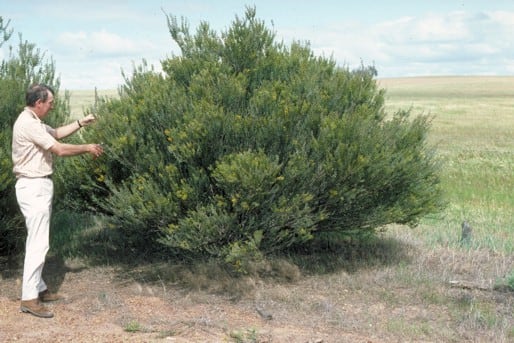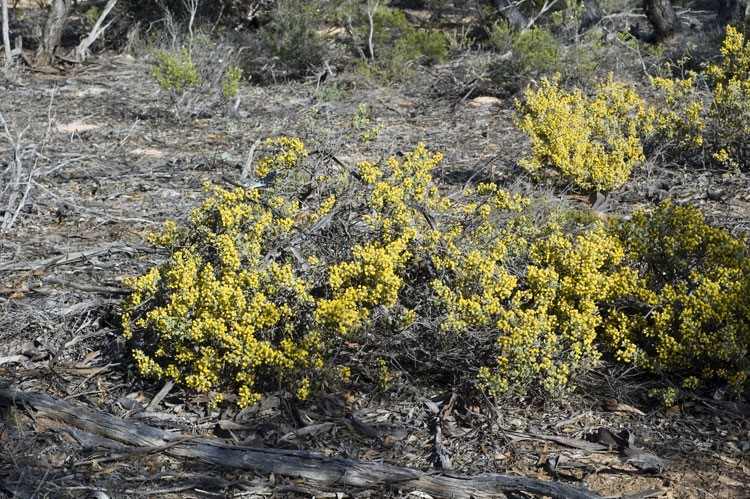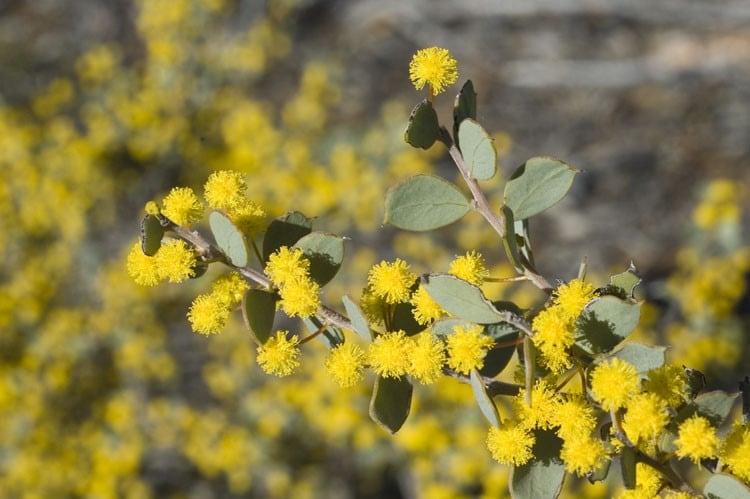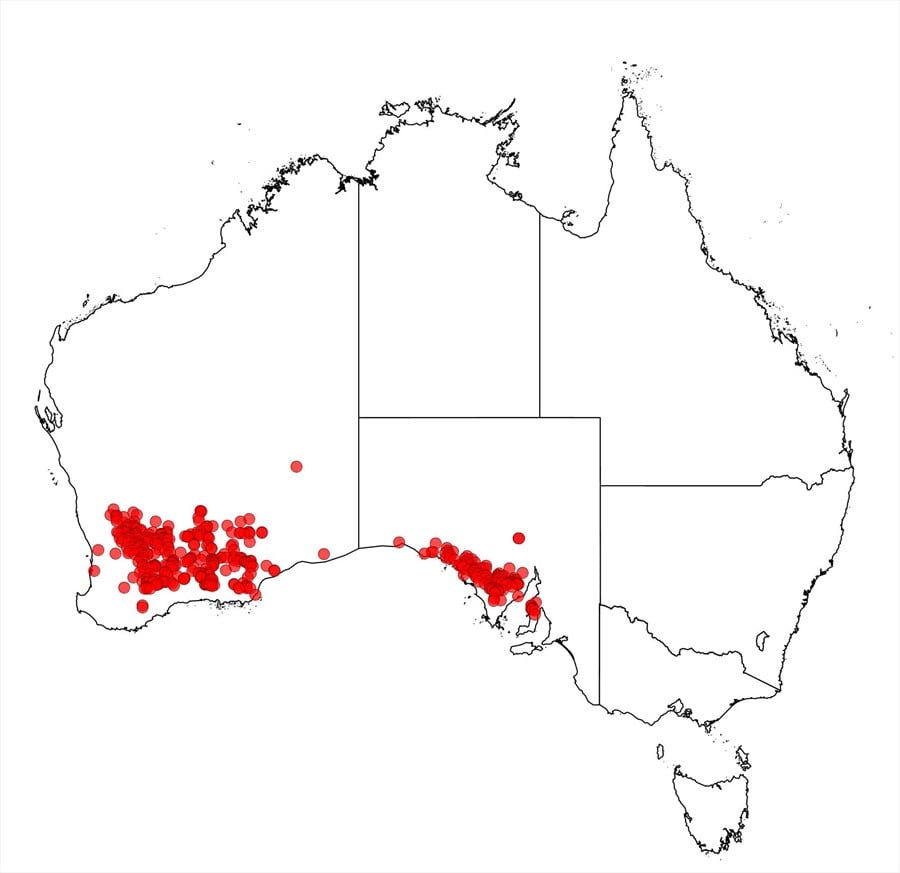Acacia merrallii F.Muell.
WATTLE
Acacias of Australia
Common Name
Merrall’s Wattle
Family
Fabaceae
Distribution
Occurs from Wubin to Pingrup, south-western W.A. E to Madura, W.A. and the Moonta–Maitland area, Yorke Peninsula, S.A.
Description
Dense ±rounded spreading shrub to 1.5 m high. Branchlets usually minutely puberulous with straight or slightly curved hairs. Phyllodes obliquely obovate to elliptic-orbicular or oblong-elliptic, rarely ovate, usually 8–25 mm long and 5–17 mm wide with l:w = 1.2–3, often slightly undulate, with innocuous to ±pungent curved or straight mucro, thick, coriaceous, smooth, grey-green to glaucescent, finely appressed-hairy when young, commonly glabrescent; midrib obscure; lateral nerves ±absent; margins prominent, yellowish; gland on lower half of phyllode, not raised. Inflorescences rudimentary, 1–3-headed racemes to 1 mm long; peduncles 6–18 mm long, glabrous; heads globular, 4–5 mm diam., 22–35-flowered, golden. Flowers 5-merous; sepals free. Pods arcuate to ±irregularly coiled, semi-terete, to 2 cm long (unexpanded length), 2–3 mm wide, thinly coriaceous-crustaceous, dark brown to black, glabrous or subglabrous. Seeds longitudinal, c. 2.5 mm long; aril conspicuous, enclosing to 1/3 of seed, usually orange.
Habitat
Grows in clay, sandy clay, sand, sandy loam and clay loam.
Specimens
W.A.: near Jibberding, W.E.Blackall 3783 (PERTH); 26 km E of Madura on Eyre Hwy, A.S.George 11831 (PERTH); 15 km W of Kambalda, B.R.Maslin 1906 (AD, DNA, PERTH). S.A.: 54.5 km towards Streaky Bay from road junction 6 km E of Ceduna, N.Hall H80/69 (NSW, PERTH); 16 km E of Pimba, 30 Sept. 1961, J.H.Willis s.n. (PERTH).
Notes
A variable species with several variants (some of which probably deserve formal recognition) falling outside the morphological parameters given above. The most common are: 1. phyllodes narrower than normal (2-4 mm wide, l:w = 3-4), arils bright yellow. Occurs especially near Salmon Gums, W.A. (e.g. B.R.Maslin 5447b , PERTH); 2. phyllodes atypically elongate (2-4 cm long, 5-8 mm wide, l:w = 3-7). Occurs in the Norseman area and E of Coonana, W.A. (e.g. R.D.Royce 5452 , PERTH); 3. branchlets densely tomentulose to minutely woolly; phyllodes 15-30 mm long, 6-10 mm wide, ±appressed-pubescent but glabrescent, with apical mucro often incurved. Occurs near Newdegate, W.A. (e.g. B.R.Maslin 3851 , PERTH); 4. stipules persistent, peduncles coarse. Occurs in the Grass Patch to Truslove area, W.A. (e.g. B.R.Maslin 6111 , PERTH); 5. seeds with vivid yellow aril, fruiting peduncles to 23 mm long. Occurs in Bendering, W.A. (e.g. B.R.Maslin 6504 , PERTH); and, 6. phyllodes 5-6 mm long, widely elliptic to nearly circular with raised midrib. Occurs in Grass Patch area, W.A. (e.g. B.R.Maslin 5444 , PERTH). Related to A. acoma, A. mutabilis, A. glaucissima and A. sericocarpa. Appears to hybridise in places with A. poliochroa and A. tetraptera in W.A. and with A. halliana in S.A. In many respects similar to A. excentrica (the variant from Ravensthorpe Ra. in particular) which has narrowly elliptic to oblong-elliptic phyllodes with the midrib usually central, as well as pubescent to villous branchlets. Distinguished from the sometimes aborescent A. ligustrina by less elongate, much thicker phyllodes with solitary glands. Inflorescences and pods suggest affinities with A. glaucoptera, a species with bifariously winged branches which was placed in series Alatae by G. Bentham, Fl. Austral. 2: 320 (1864). Acacia bracteolata is similar in phyllode shape and size. Some forms may resemble A. dorsenna.
FOA Reference
Data derived from Flora of Australia Volumes 11A (2001), 11B (2001) and 12 (1998), products of ABRS, ©Commonwealth of Australia
Author
B.R.Maslin
Minor edits by J.Reid
This identification key and fact sheets are available as a mobile application:
URL: https://apps.lucidcentral.org/wattle/
© Copyright 2018. All rights reserved.















